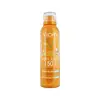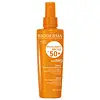What's inside
What's inside
 Key Ingredients
Key Ingredients

 Benefits
Benefits

 Concerns
Concerns

 Ingredients Side-by-side
Ingredients Side-by-side

Butane
Water
Skin ConditioningDicaprylyl Ether
EmollientHomosalate
Skin ConditioningDrometrizole Trisiloxane
UV AbsorberEthylhexyl Salicylate
UV AbsorberDimethicone
EmollientStyrene/Acrylates Copolymer
Octocrylene
UV AbsorberButyl Methoxydibenzoylmethane
UV AbsorberPEG-30 Dipolyhydroxystearate
EmulsifyingNylon-12
Dicaprylyl Carbonate
EmollientMethyl Methacrylate Crosspolymer
Cyclohexasiloxane
EmollientPolymethylsilsesquioxane
P-Anisic Acid
MaskingCaprylyl Glycol
EmollientDisodium EDTA
Disteardimonium Hectorite
StabilisingDodecene
MaskingEthylhexyl Triazone
UV AbsorberIsododecane
EmollientIsostearyl Alcohol
EmollientLauryl PEG/PPG-18/18 Methicone
Skin ConditioningPEG-8 Laurate
EmulsifyingPhenoxyethanol
PreservativePoloxamer 407
EmulsifyingPoly C10-30 Alkyl Acrylate
Emulsion StabilisingPropylene Carbonate
SolventSodium Chloride
MaskingTocopherol
AntioxidantButane, Water, Dicaprylyl Ether, Homosalate, Drometrizole Trisiloxane, Ethylhexyl Salicylate, Dimethicone, Styrene/Acrylates Copolymer, Octocrylene, Butyl Methoxydibenzoylmethane, PEG-30 Dipolyhydroxystearate, Nylon-12, Dicaprylyl Carbonate, Methyl Methacrylate Crosspolymer, Cyclohexasiloxane, Polymethylsilsesquioxane, P-Anisic Acid, Caprylyl Glycol, Disodium EDTA, Disteardimonium Hectorite, Dodecene, Ethylhexyl Triazone, Isododecane, Isostearyl Alcohol, Lauryl PEG/PPG-18/18 Methicone, PEG-8 Laurate, Phenoxyethanol, Poloxamer 407, Poly C10-30 Alkyl Acrylate, Propylene Carbonate, Sodium Chloride, Tocopherol
Water
Skin ConditioningDicaprylyl Carbonate
EmollientOctocrylene
UV AbsorberMethylene Bis-Benzotriazolyl Tetramethylbutylphenol
UV FilterButyl Methoxydibenzoylmethane
UV AbsorberBis-Ethylhexyloxyphenol Methoxyphenyl Triazine
Skin ConditioningGlycerin
HumectantMethylpropanediol
SolventEctoin
Skin ConditioningMannitol
HumectantXylitol
HumectantRhamnose
HumectantFructooligosaccharides
HumectantLaminaria Ochroleuca Extract
Skin ConditioningAcetyl Tyrosine
Skin ConditioningHelianthus Annuus Seed Oil
EmollientOleoyl Tyrosine
Skin ConditioningMedicago Sativa Extract
TonicSqualane
EmollientJuglans Regia Shell Extract
Skin ConditioningHypericum Perforatum Extract
AntimicrobialAcetyl Hexapeptide-1
Skin ConditioningDextran
Isopropyl Myristate
EmollientDecyl Glucoside
CleansingC20-22 Alkyl Phosphate
EmulsifyingC20-22 Alcohols
Emulsion StabilisingTrilinolein
Skin ConditioningAspartic Acid
MaskingCetearyl Alcohol
EmollientXanthan Gum
EmulsifyingCoco-Glucoside
CleansingButylene Glycol
HumectantTrilinolenin
EmollientTriolein
Skin ConditioningHydroxyethyl Acrylate/Sodium Acryloyldimethyl Taurate Copolymer
Emulsion StabilisingOleic Acid
EmollientTripalmitin
Skin ConditioningTristearin
Skin ConditioningPropylene Glycol
HumectantPolysorbate 60
EmulsifyingCopper Gluconate
Skin ConditioningCaprylic/Capric Triglyceride
MaskingCitric Acid
BufferingSodium Hydroxide
BufferingDisodium EDTA
Chlorphenesin
AntimicrobialPhenoxyethanol
PreservativeParfum
MaskingWater, Dicaprylyl Carbonate, Octocrylene, Methylene Bis-Benzotriazolyl Tetramethylbutylphenol, Butyl Methoxydibenzoylmethane, Bis-Ethylhexyloxyphenol Methoxyphenyl Triazine, Glycerin, Methylpropanediol, Ectoin, Mannitol, Xylitol, Rhamnose, Fructooligosaccharides, Laminaria Ochroleuca Extract, Acetyl Tyrosine, Helianthus Annuus Seed Oil, Oleoyl Tyrosine, Medicago Sativa Extract, Squalane, Juglans Regia Shell Extract, Hypericum Perforatum Extract, Acetyl Hexapeptide-1, Dextran, Isopropyl Myristate, Decyl Glucoside, C20-22 Alkyl Phosphate, C20-22 Alcohols, Trilinolein, Aspartic Acid, Cetearyl Alcohol, Xanthan Gum, Coco-Glucoside, Butylene Glycol, Trilinolenin, Triolein, Hydroxyethyl Acrylate/Sodium Acryloyldimethyl Taurate Copolymer, Oleic Acid, Tripalmitin, Tristearin, Propylene Glycol, Polysorbate 60, Copper Gluconate, Caprylic/Capric Triglyceride, Citric Acid, Sodium Hydroxide, Disodium EDTA, Chlorphenesin, Phenoxyethanol, Parfum
Ingredients Explained
These ingredients are found in both products.
Ingredients higher up in an ingredient list are typically present in a larger amount.
Also known as Avobenzone, this ingredient is a chemical sunscreen filter that provides protection in the UV-A range.
Avobenzone is globally approved and is the most commonly used UV-A filter in the world.
Studies have found that avobenzone becomes ineffective when exposed to UV light (it is not photostable; meaning that it breaks down in sunlight). Because of this, formulations that include avobenzone will usually contain stabilizers such as octocrylene.
However, some modern formulations (looking at you, EU!) are able to stabilize avobenzone by coating the molecules.
Avobenzone does not protect against the UV-B range, so it's important to check that the sunscreen you're using contains other UV filters that do!
The highest concentration of avobenzone permitted is 3% in the US, and 5% in the EU.
Learn more about Butyl MethoxydibenzoylmethaneDicaprylyl Carbonate comes from carbonic acid and caprylyl alcohol, a fatty alcohol. It is an emollient and gives skin a velvet feel. The sources of Dicaprylyl Carbonate may be synthetic or from animals.
As an emollient, Dicaprylyl Carbonate creates a film on the skin. This film traps moisture in, keeping your skin soft and hydrated.
Disodium EDTA plays a role in making products more stable by aiding other preservatives.
It is a chelating agent, meaning it neutralizes metal ions that may be found in a product.
Disodium EDTA is a salt of edetic acid and is found to be safe in cosmetic ingredients.
Learn more about Disodium EDTAOctocrylene protects skin from sun damage. It absorbs UV-B with peak absorption of 304 nm. It is a common sunscreen ingredient and often paired with avobenzone, a UVA filter. This is because octocrylene stabilizes other sunscreen ingredients by protecting them from degradation when exposed to sunlight. Octocrylene is a photostable ingredient and loses about 10% of SPF in 95 minutes.
Octocrylene also acts as an emollient, meaning it helps skin retain moisture and softens skin. It is oil-soluble and hydrophobic, enhancing water-resistant properties in a product.
Those who are using ketoprofen, a topical anti-inflammatory drug, may experience an allergic reaction when using octocrylene. It is best to speak with a healthcare professional about using sunscreens with octocrylene.
The EU allows a maximum of these concentrations:
Learn more about OctocrylenePhenoxyethanol is a preservative that has germicide, antimicrobial, and aromatic properties. Studies show that phenoxyethanol can prevent microbial growth. By itself, it has a scent that is similar to that of a rose.
It's often used in formulations along with Caprylyl Glycol to preserve the shelf life of products.
Water. It's the most common cosmetic ingredient of all. You'll usually see it at the top of ingredient lists, meaning that it makes up the largest part of the product.
So why is it so popular? Water most often acts as a solvent - this means that it helps dissolve other ingredients into the formulation.
You'll also recognize water as that liquid we all need to stay alive. If you see this, drink a glass of water. Stay hydrated!
Learn more about Water